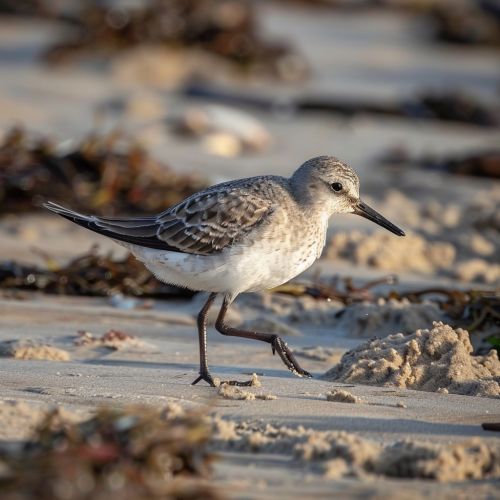Sandpipers
Introduction
Sandpipers are a diverse group of shorebirds belonging to the family Scolopacidae. This family encompasses a wide range of species that are commonly found along shorelines, mudflats, and wetlands across the globe. Sandpipers are known for their distinctive probing behavior, long legs, and slender bills, which they use to forage for invertebrates in the substrate.
Taxonomy and Classification
The family Scolopacidae is part of the order Charadriiformes, which also includes plovers, gulls, and auks. Within Scolopacidae, there are several genera, each containing multiple species. Some of the most well-known genera include Calidris, Tringa, and Actitis. The classification of sandpipers is based on morphological characteristics, vocalizations, and genetic data.
Morphology
Sandpipers exhibit a wide range of morphological adaptations that enable them to thrive in their respective habitats. Their bills vary in length and curvature, allowing different species to exploit various ecological niches. For example, the Curlew Sandpiper (Calidris ferruginea) has a long, decurved bill ideal for probing deep into the mud, while the Dunlin (Calidris alpina) has a shorter, straighter bill suited for picking prey from the surface.


Behavior and Ecology
Sandpipers are primarily migratory birds, undertaking long-distance migrations between their breeding and wintering grounds. Their migratory routes often span continents, with some species traveling from the Arctic to the southern hemisphere. During migration, sandpipers rely on stopover sites to rest and refuel. These sites are crucial for their survival and include estuaries, mudflats, and coastal lagoons.
Sandpipers are known for their foraging behavior, which involves probing the substrate with their bills to locate prey. Their diet consists mainly of invertebrates such as insects, crustaceans, and mollusks. Some species, like the Red Knot (Calidris canutus), have specialized feeding strategies that allow them to exploit specific food resources during different stages of their life cycle.
Breeding and Reproduction
Sandpipers typically breed in the high Arctic tundra, where they establish territories and build nests on the ground. The breeding season is short, and pairs must quickly lay eggs and raise their chicks before the onset of winter. Sandpiper nests are simple scrapes in the ground, lined with vegetation and other materials.
The incubation period for sandpiper eggs varies among species but generally lasts between 20 to 30 days. Both parents often share incubation duties, although in some species, the female may leave the nest after laying the eggs, leaving the male to incubate and care for the chicks. Sandpiper chicks are precocial, meaning they are relatively mature and mobile shortly after hatching. They leave the nest within a few days and begin foraging for food under the watchful eyes of their parents.
Conservation Status
Many sandpiper species are facing significant threats due to habitat loss, climate change, and human disturbance. Coastal development, wetland drainage, and pollution have led to the degradation of critical stopover and breeding sites. Climate change is also altering the availability of food resources and the timing of migration, further challenging sandpiper populations.
Conservation efforts for sandpipers focus on protecting and restoring key habitats, monitoring populations, and implementing international agreements such as the Ramsar Convention and the Migratory Bird Treaty Act. Organizations like the International Wader Study Group and BirdLife International play a crucial role in coordinating conservation actions and raising awareness about the plight of these shorebirds.
Notable Species
Red Knot (Calidris canutus)
The Red Knot is renowned for its remarkable migratory journey, traveling up to 15,000 kilometers between its breeding grounds in the Arctic and its wintering sites in South America. This species relies heavily on intertidal habitats during migration, where it feeds on bivalves and other invertebrates.
Sanderling (Calidris alba)
The Sanderling is a small, pale sandpiper commonly seen running along sandy beaches, chasing waves to forage for small crustaceans and insects. It breeds in the high Arctic and migrates to coastal regions worldwide during the non-breeding season.
Common Sandpiper (Actitis hypoleucos)
The Common Sandpiper is a widespread species found across Europe, Asia, and Africa. It is easily recognizable by its distinctive teetering motion and characteristic "teetering" call. This species prefers freshwater habitats such as rivers, lakes, and marshes.
